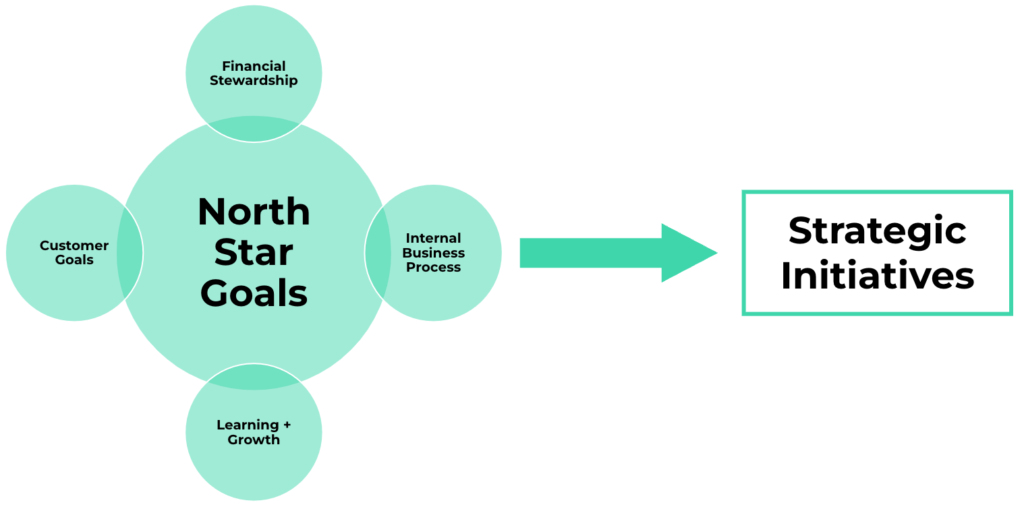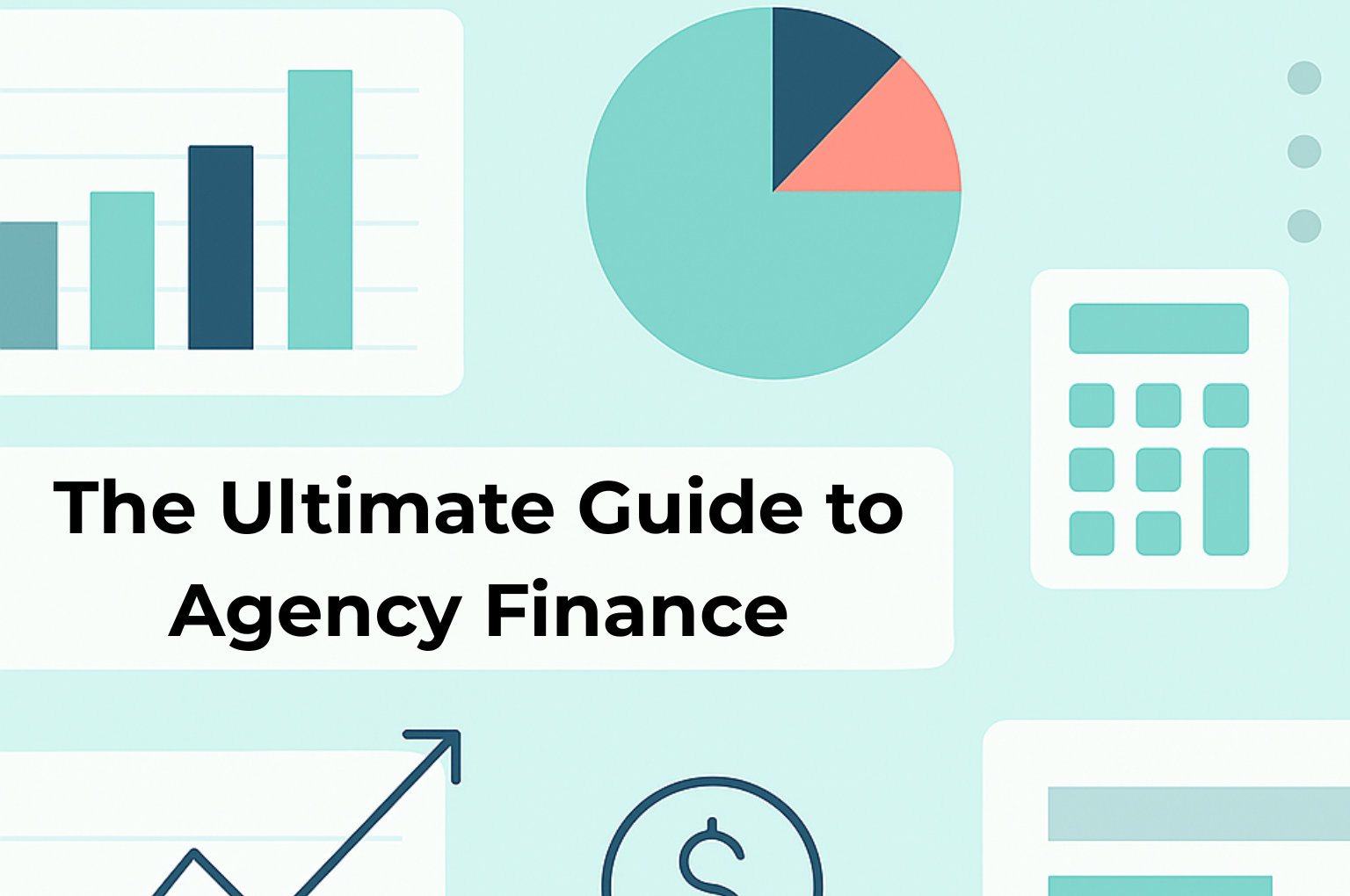One question that consistently comes up at this time of year is how I set targets for our organisation. It’s a process that seems arduous and complex but in reality, it can be made more logical and easier than you think.
Here at Scaled we have several different approaches to helping agencies set good annual targets and then understand how to cascade them through the wider organisation. A process that ensures everyone is truly aligned and is provided with clarity of expectation from day one of the year.
The ability to provide accountability, clarity, and delegate that responsibility is a key hurdle in the agency scaling journey. And so, let’s look at one of our most regularly used processes for doing this.
The Balanced Scorecard approach
Starting is often the hardest part of creating a target framework for your organisation and one of the best ways of doing that is via an age-old framework called The Balanced Scorecard.
Twenty years ago, Professor Robert Kaplan and Dr David Norton created the approach as a performance measurement framework that incorporated non-financial measures into metrics to give managers a more ‘balanced’ view of organisational performance. It is used extensively throughout business and industry, government, and not-for-profit organisations to align business activities to the strategy of the organisation.
It’s important at this point to say that this process sits inside of a longer-term ambition and target setting process (which we call North Star Goal setting) that we always run through during the initial phase of our work with a new agency client – but what it does do is tie the rest of the organisation to those top-level revenue and EBITDA (profit) targets and help ensure they are met.
The thinking is that what you measure is what you get from a results perspective and so setting purely financial targets usually only work for experienced and senior team members. Hard-edged financially framed goals worked well in the days of industry but for service companies like agencies, which are nothing more than a sum of the collection of their people, we need to create targets that help to progress innovation, product, and many other key areas.
The Balanced Scorecard approach allows us to do this. Yes, it includes financial targets, but it also widens the aperture, taking in three other key focus areas.
The four balanced scorecard perspectives
The balanced scorecard approach examines performance from four perspectives.
- Financial analysis, which includes measures such as operating income, profitability and return on investment.
- Customer analysis, which looks at investment in customer service and retention.
- Internal analysis, which looks at how internal business processes are linked to strategic goals.
- The learning and growth perspective assesses employee satisfaction and retention, as well as information system.
These four perspectives bring together disparate elements of a company’s competitive agenda in a single report and allow you to have all the important operational metrics together, forcing managers to consider whether one improvement has been achieved at the expense of another.
Where it fits
This framework sits neatly between our initial North Star Goal and the actionable Strategic Initiatives from which we can begin to action the specific projects and tactical things required to move the needle.
Originally the approach was to set the Four Perspectives around the areas of the business laid out below, although our approach can sometimes differ in that we edit that list slightly to better reflect the specifics of agencies.
In this instance we focus instead on Financial, Operations, Communication and People. But, for this example, we will stick more closely to the original format, which looks a little like this…

With North Star set we can then begin the process of establishing outputs for the Four perspectives, so let’s look at an example of that output now.
Financial
This is the most traditional area and within it we will often set targets such as revenue, Operating profit, margin, new business, and upsell/cross sell targets etc.
Customer
You will also want to examine your company’s activities from your clients’ perspective. How do view the quality of your work or communication? What are the reviews and feedback? Do you have an objective measure of customer satisfaction from surveys or other sources? A negative perception of your approach will impact retention and your ability to grow average client account values.
Internal Business Processes
It’s also important to examine the agency’s internal processes to look for areas ripe for improvement by removing inefficiencies and identifying error-prone portions. Would it help the company’s strategic goal if some processes were faster or cost less?
Learning and Growth
This area examines the company’s health in terms of training employees, mentoring in a way that helps them grow and contribute, and employing the latest tools and systems to foster innovation. You may also want to examine how fast your agency responds to change and how long it takes a team to develop a new product and bring it to market. This is critical in the rapidly evolving marketing services and design and development sectors.
The scorecard
The idea is to work collectively with senior team and team leaders to create a list of 3-6 key objectives under each of the four perspectives. These are always unique to your agency business but here is an example to help give you a feel for the output.
Strategy | ||||
| Objectives | Measures | Targets | Initiatives | |
| Financial | Increase Margin | Increase in profit | 35% Rev/OP margin | New time tracking process |
| Customer | Increase average account value | Average 12-month retainer > £8,000 | Increase by 15% to £8500 | Upsell/cross sell targets set & new process in place |
| Processes | Improve BI Reporting | New SLT dashboard captures key KPIs | Dashboard – margin by team, utilisation, capacity, rev, OP | Reporting project launched & delivered |
| Learning & Growth | Widen service offering | 1+ new channel launched in 2023 | £100,000 in the year from new channel | Launch survey project to existing clients |
The next step
With this top-level work completed and a clear overall set of targets set for the year we can then move into the more detailed Strategic Initiatives project, which further breaks down all the actions that need to be taken and projects completed to achieve the overall objectives set above.
That process, as well as the approach which pushes these four perspectives and cascades clear targets and responsibilities into each team within your agency is a post for another day.
—
How do you find the process of setting targets and getting buy in from every member of staff? If you find it challenging and want to learn more about the above, then feel free to drop us a quick email at hello@scaled.co.uk.
One question that consistently comes up at this time of year is how I set targets for our organisation. It’s a process that seems arduous and complex but in reality, it can be made more logical and easier than you think.
Here at Scaled we have several different approaches to helping agencies set good annual targets and then understand how to cascade them through the wider organisation. A process that ensures everyone is truly aligned and is provided with clarity of expectation from day one of the year.
The ability to provide accountability, clarity, and delegate that responsibility is a key hurdle in the agency scaling journey. And so, let’s look at one of our most regularly used processes for doing this.
The Balanced Scorecard approach
Starting is often the hardest part of creating a target framework for your organisation and one of the best ways of doing that is via an age-old framework called The Balanced Scorecard.
Twenty years ago, Professor Robert Kaplan and Dr David Norton created the approach as a performance measurement framework that incorporated non-financial measures into metrics to give managers a more ‘balanced’ view of organisational performance. It is used extensively throughout business and industry, government, and not-for-profit organisations to align business activities to the strategy of the organisation.
It’s important at this point to say that this process sits inside of a longer-term ambition and target setting process (which we call North Star Goal setting) that we always run through during the initial phase of our work with a new agency client – but what it does do is tie the rest of the organisation to those top-level revenue and EBITDA (profit) targets and help ensure they are met.
The thinking is that what you measure is what you get from a results perspective and so setting purely financial targets usually only work for experienced and senior team members. Hard-edged financially framed goals worked well in the days of industry but for service companies like agencies, which are nothing more than a sum of the collection of their people, we need to create targets that help to progress innovation, product, and many other key areas.
The Balanced Scorecard approach allows us to do this. Yes, it includes financial targets, but it also widens the aperture, taking in three other key focus areas.
The four balanced scorecard perspectives
The balanced scorecard approach examines performance from four perspectives.
- Financial analysis, which includes measures such as operating income, profitability and return on investment.
- Customer analysis, which looks at investment in customer service and retention.
- Internal analysis, which looks at how internal business processes are linked to strategic goals.
- The learning and growth perspective assesses employee satisfaction and retention, as well as information system.
These four perspectives bring together disparate elements of a company’s competitive agenda in a single report and allow you to have all the important operational metrics together, forcing managers to consider whether one improvement has been achieved at the expense of another.
Where it fits
This framework sits neatly between our initial North Star Goal and the actionable Strategic Initiatives from which we can begin to action the specific projects and tactical things required to move the needle.
Originally the approach was to set the Four Perspectives around the areas of the business laid out below, although our approach can sometimes differ in that we edit that list slightly to better reflect the specifics of agencies.
In this instance we focus instead on Financial, Operations, Communication and People. But, for this example, we will stick more closely to the original format, which looks a little like this…

With North Star set we can then begin the process of establishing outputs for the Four perspectives, so let’s look at an example of that output now.
Financial
This is the most traditional area and within it we will often set targets such as revenue, Operating profit, margin, new business, and upsell/cross sell targets etc.
Customer
You will also want to examine your company’s activities from your clients’ perspective. How do view the quality of your work or communication? What are the reviews and feedback? Do you have an objective measure of customer satisfaction from surveys or other sources? A negative perception of your approach will impact retention and your ability to grow average client account values.
Internal Business Processes
It’s also important to examine the agency’s internal processes to look for areas ripe for improvement by removing inefficiencies and identifying error-prone portions. Would it help the company’s strategic goal if some processes were faster or cost less?
Learning and Growth
This area examines the company’s health in terms of training employees, mentoring in a way that helps them grow and contribute, and employing the latest tools and systems to foster innovation. You may also want to examine how fast your agency responds to change and how long it takes a team to develop a new product and bring it to market. This is critical in the rapidly evolving marketing services and design and development sectors.
The scorecard
The idea is to work collectively with senior team and team leaders to create a list of 3-6 key objectives under each of the four perspectives. These are always unique to your agency business but here is an example to help give you a feel for the output.
| Strategy | ||||
| Objectives | Measures | Targets | Initiatives | |
| Financial | Increase Margin | Increase in profit | 35% Rev/OP margin | New time tracking process |
| Customer | Increase average account value | Average 12-month retainer > £8,000 | Increase by 15% to £8500 | Upsell/cross sell targets set & new process in place |
| Processes | Improve BI Reporting | New SLT dashboard captures key KPIs | Dashboard – margin by team, utilisation, capacity, rev, OP | Reporting project launched & delivered |
| Learning & Growth | Widen service offering | 1+ new channel launched in 2023 | £100,000 in the year from new channel | Launch survey project to existing clients |
The next step
With this top-level work completed and a clear overall set of targets set for the year we can then move into the more detailed Strategic Initiatives project, which further breaks down all the actions that need to be taken and projects completed to achieve the overall objectives set above.
That process, as well as the approach which pushes these four perspectives and cascades clear targets and responsibilities into each team within your agency is a post for another day.
—
How do you find the process of setting targets and getting buy in from every member of staff? If you find it challenging and want to learn more about the above, then feel free to drop us a quick email at hello@scaled.co.uk.



